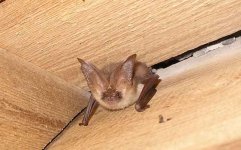P
peter hayes
Guest
From NATURE
The aerial war of moths and bats by SARA ABDULLA
A warplane homes in on its target. Flying in darkness, it finds its prey by sending out streams of short, intense pulses of ultrasound, each far beyond the range of human hearing. But the target does not give in so easily, and fights ultrasound with ultrasound: detecting the homing signal, the target dodges evasively to avoid attack. Sometimes, it counter-attacks with blasts of ultrasound of its own that confuse and disorient the attacker.
A picture of modern aerial warfare? Yes — but warfare in nature, between bats and their hawkmoth prey. In a report in the Journal of Experimental Biology, Martin C. Göpfert of the University of Zürich, Switzerland, and Lutz T. Wasserthal of the University of Erlangen-Nürnberg, Germany show how some species of hawkmoth have hearing organs tuned to pick up the ultrasonic chirps of bats, and how the moths respond to such signals by evasive flying manoeuvres.
Until Göpfert and Wasserthal's study, only a few hawkmoths, in the moth subfamily Choerocampinae, were known to have hearing organs sensitive to ultrasound. The fact that these hearing organs were made from modified mouthparts "caused great surprise when they were first identified", the researchers comment.
The hearing organs are made by a combination of two mouthparts: the normally tentacle-like labial 'palps' (equivalent to an insect's 'lips') are modified into stiff, thin-walled, air-filled resonating chambers, which press onto the underlying 'labral pilifers', modified into a set of brush-like sensory filaments sensitive to sound. The pilifers are absolutely essential to the perception of ultrasound: moths without the palps can hear it, but with much less sensitivity than normal.
Göpfert and Wasserthal have now found that the same mouthparts have been pressed into ultrasonic service in a distantly related group of hawkmoths, the Acherontiinae. The modifications are different, but the end result is the same: acherontiine moths, which include the familiar 'Death's Head' hawkmoth (Acherontia atropos), use their modified mouthparts to detect the squeaks of predatory bats. When subjected to the appropriate frequencies in the laboratory, the moths responded by evasive flying. "Since the tuning of the acoustic responses in large acherontiine species seems to reflect specific adaptations to the echolocation frequencies of some large bat species, hearing in these hawkmoths presumably evolved in response to predation pressure exerted by these bats," the researchers say.
And the moths fought back — in addition to stunt flying, some moths produced their own ultrasound in response to receiving it. The reason, the researchers speculate, is to frighten away the attacking bat, an idea supported by a single observation of a Death's Head hawkmoth under attack by two bats. The moth produced a sound that startled the bats.
The aerial war of moths and bats by SARA ABDULLA
A warplane homes in on its target. Flying in darkness, it finds its prey by sending out streams of short, intense pulses of ultrasound, each far beyond the range of human hearing. But the target does not give in so easily, and fights ultrasound with ultrasound: detecting the homing signal, the target dodges evasively to avoid attack. Sometimes, it counter-attacks with blasts of ultrasound of its own that confuse and disorient the attacker.
A picture of modern aerial warfare? Yes — but warfare in nature, between bats and their hawkmoth prey. In a report in the Journal of Experimental Biology, Martin C. Göpfert of the University of Zürich, Switzerland, and Lutz T. Wasserthal of the University of Erlangen-Nürnberg, Germany show how some species of hawkmoth have hearing organs tuned to pick up the ultrasonic chirps of bats, and how the moths respond to such signals by evasive flying manoeuvres.
Until Göpfert and Wasserthal's study, only a few hawkmoths, in the moth subfamily Choerocampinae, were known to have hearing organs sensitive to ultrasound. The fact that these hearing organs were made from modified mouthparts "caused great surprise when they were first identified", the researchers comment.
The hearing organs are made by a combination of two mouthparts: the normally tentacle-like labial 'palps' (equivalent to an insect's 'lips') are modified into stiff, thin-walled, air-filled resonating chambers, which press onto the underlying 'labral pilifers', modified into a set of brush-like sensory filaments sensitive to sound. The pilifers are absolutely essential to the perception of ultrasound: moths without the palps can hear it, but with much less sensitivity than normal.
Göpfert and Wasserthal have now found that the same mouthparts have been pressed into ultrasonic service in a distantly related group of hawkmoths, the Acherontiinae. The modifications are different, but the end result is the same: acherontiine moths, which include the familiar 'Death's Head' hawkmoth (Acherontia atropos), use their modified mouthparts to detect the squeaks of predatory bats. When subjected to the appropriate frequencies in the laboratory, the moths responded by evasive flying. "Since the tuning of the acoustic responses in large acherontiine species seems to reflect specific adaptations to the echolocation frequencies of some large bat species, hearing in these hawkmoths presumably evolved in response to predation pressure exerted by these bats," the researchers say.
And the moths fought back — in addition to stunt flying, some moths produced their own ultrasound in response to receiving it. The reason, the researchers speculate, is to frighten away the attacking bat, an idea supported by a single observation of a Death's Head hawkmoth under attack by two bats. The moth produced a sound that startled the bats.




